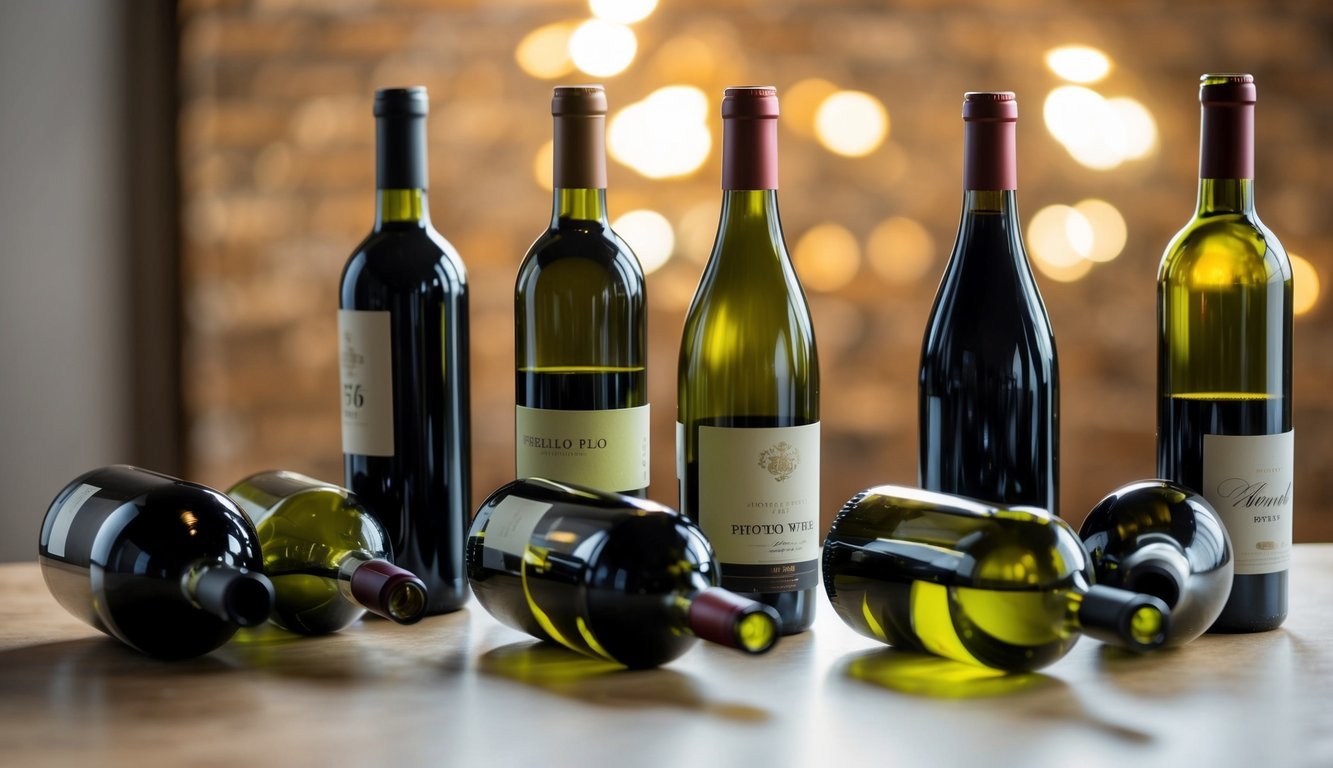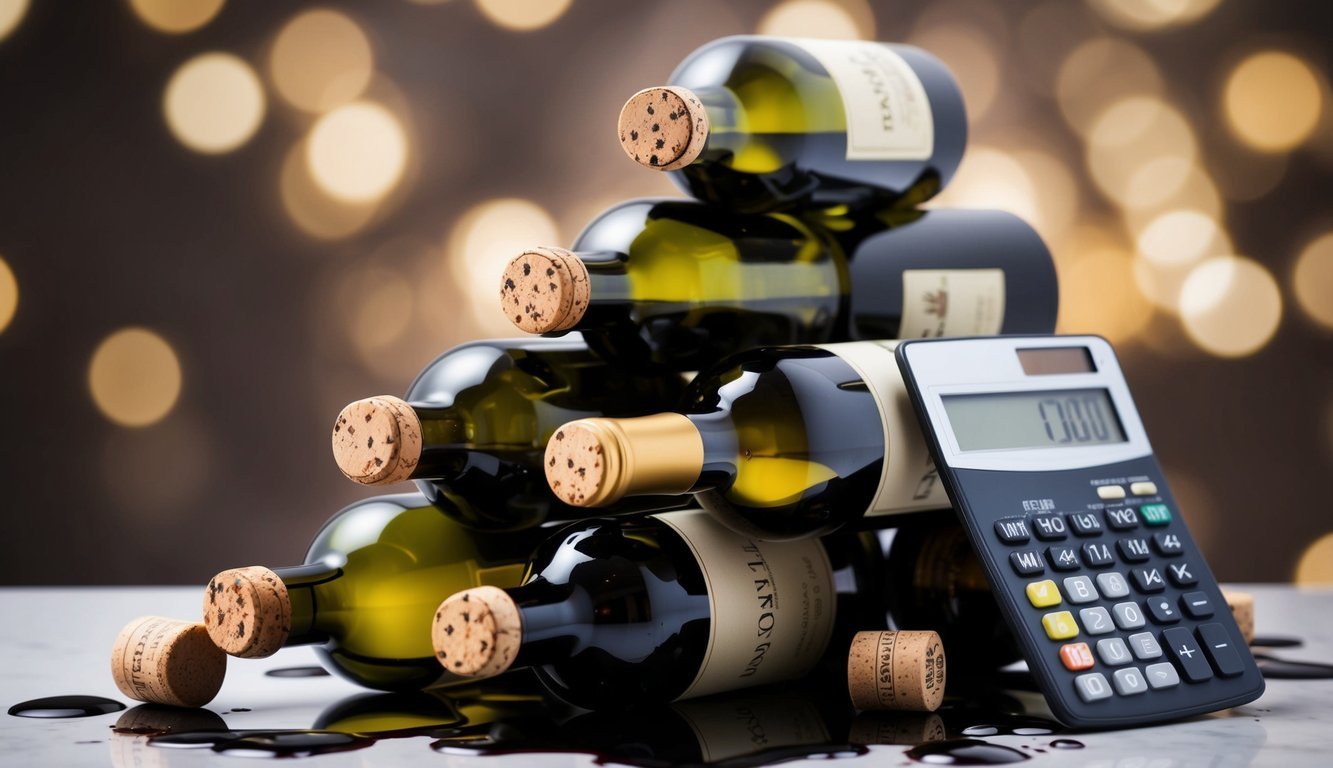Wine enthusiasts come in all shapes and sizes, from casual sippers to dedicated connoisseurs.
You might be surprised to learn how your wine-drinking habits stack up against others and what impact they have on your wallet.
Whether you’re a weekend indulger or a daily devotee, your wine preferences and consumption patterns can significantly affect your annual spending.
The average American wine drinker spends between $200 and $500 per year on their favorite bottles. However, this figure can vary dramatically depending on your drinking style and preferences.
From budget-conscious buyers to luxury label lovers, each type of wine drinker has a unique spending profile.
Understanding where you fit in this spectrum can help you make more informed choices about your wine purchases and potentially save you money in the long run.
1) Leftover Wine from Parties
You’ve probably thrown a party or two where wine was served.
But have you ever wondered how much of that wine goes to waste? It’s more than you might think.
Leftover wine from parties is a common source of waste for many wine drinkers.
Often, hosts buy more wine than necessary to ensure they don’t run out.
This overestimation leads to partially consumed bottles at the end of the night.
You might find yourself with several open bottles that won’t stay fresh for long.
Some hosts pour leftover wine down the drain, not realizing its potential uses.
Others may keep it, intending to drink it later, but forget about it until it’s no longer good.
To reduce waste, try using a drink calculator before your next party.
These tools can help you estimate how much wine you’ll actually need based on guest count and party duration.
Consider offering smaller pours or using wine preservation systems for opened bottles.
You can also get creative with leftover wine by using it in cooking or making vinegar.
Remember, every bottle of wine wasted is money down the drain.
By being mindful of your purchases and finding uses for leftovers, you can significantly reduce your annual wine waste.
2) Unfinished Bottles After Dinner

Have you ever opened a bottle of wine during dinner, only to leave it half-full at the end of the night? You’re not alone.
Many wine drinkers struggle with this common scenario.
The cost of unfinished bottles can quickly add up.
On average, you might waste $10-15 per bottle if you don’t finish it within a few days.
To minimize waste, consider investing in a wine preservation system.
These devices can help keep your opened wine fresh for longer periods.
Another option is to plan your meals and wine consumption more carefully.
Try to choose bottle sizes that match your typical consumption.
If you find yourself with leftover wine, don’t let it go to waste.
You can use it for cooking or make wine vinegar at home.
Remember, refrigerating your opened red wine can help it last a bit longer.
Just be sure to take it out and let it warm up before serving again.
By being mindful of your wine consumption habits, you can significantly reduce waste and save money in the long run.
3) Sampling Wastes at Wine Tastings

Wine tastings can lead to unexpected waste for enthusiastic samplers.
You might find yourself pouring out more wine than you realize during these events.
Many tasters feel obligated to try every wine offered, even if they don’t enjoy certain varieties.
This can result in wasted pours that end up in the spit bucket.
The small amounts served at tastings add up quickly.
You may sample 10-15 wines in a session, with each pour typically being 1-2 ounces.
If you’re not careful, you could easily waste 8-16 ounces of wine per tasting.
That’s equivalent to 1-2 glasses of wine poured down the drain.
Over the course of a year, frequent tasters might attend dozens of events.
This sampling waste can accumulate to several bottles’ worth of discarded wine annually.
To minimize waste, you can be more selective about which wines you try.
Focus on varieties you’re likely to enjoy or purchase.
You can also share tastings with a partner, allowing you to sample more wines without wasting as much.
Remember, it’s okay to skip certain offerings if you know they’re not to your taste.
4) Inaccurate Pour at Restaurants

When dining out, you might not realize how much wine you’re actually getting in your glass.
Restaurants often struggle with consistent pours, leading to unintended waste and lost profits.
Standard wine pours typically range from 5 to 6 ounces.
But without proper measuring tools or training, servers may accidentally overpour or underpour.
Overpouring means you’re getting more wine than you paid for, which seems great at first.
But it can lead to higher prices as restaurants try to recoup their losses.
Underpouring, on the other hand, leaves you with less wine than expected.
This might make you order another glass sooner, increasing your overall spending.
Some restaurants use pour spouts or measured glasses to ensure accuracy.
Others train their staff to recognize proper pour sizes by sight.
As a wine drinker, you can pay attention to pour sizes and politely ask about them.
This helps ensure you’re getting what you pay for and reduces waste.
By being aware of pour sizes, you can make more informed decisions about your wine consumption and spending at restaurants.
5) Corks That Ruin Wine

Cork closures can sometimes be the culprit behind ruined wine.
You might not realize it, but a faulty cork can spoil an otherwise perfect bottle.
Cork taint, often called “corked wine,” is a common issue.
It’s caused by a compound called TCA that can develop in natural corks.
This chemical can give your wine a musty, moldy smell and taste.
Even if the cork doesn’t cause taint, it can still let too much oxygen into the bottle.
This leads to oxidation, which can make your wine taste flat or stale.
These cork-related problems can waste your money in two ways.
First, you might end up pouring out the spoiled wine.
Second, you could miss out on enjoying a potentially great bottle you’ve paid for.
To avoid these issues, you might consider wines with alternative closures.
Screw caps and synthetic corks are becoming more popular.
They’re less likely to cause these problems and can help preserve your wine’s quality.
6) Improperly Stored Bottles

Storing wine incorrectly can lead to significant waste and financial loss.
You might not realize it, but improper storage can quickly turn a prized bottle into vinegar.
Temperature fluctuations are a major culprit.
If you’re keeping wine in a warm spot or near a window, you’re risking premature aging and spoilage.
Even a few degrees above ideal can accelerate the deterioration process.
Light exposure is another enemy of wine.
UV rays can break down compounds in the wine, altering its taste and aroma.
That’s why you’ll often see wine stored in dark bottles or cellars.
Humidity matters too.
Too dry, and corks can shrink, allowing air to seep in.
Too humid, and you might face mold issues.
Both scenarios can ruin your wine and your wallet.
Vibrations from nearby appliances or foot traffic can disturb sediment in older wines, affecting their flavor profile.
If you’re storing wine near a washer or high-traffic area, you might be unknowingly degrading its quality.
By improving your storage methods, you can save money and enjoy your wine as intended.
Proper storage ensures each bottle reaches its full potential, maximizing your investment and enjoyment.
Understanding Wine Expenses

Wine prices can vary dramatically based on numerous factors.
Quality, production methods, and marketing all play a role in determining what you’ll pay for a bottle.
Why Some Wines Cost More
High-end wines often come from prestigious regions with limited production.
You’re paying for the terroir, meticulous grape selection, and careful aging processes.
Rare or older vintages command higher prices due to scarcity.
Labor-intensive techniques like hand-harvesting and barrel aging increase costs.
Some wineries use expensive new oak barrels, which impart distinct flavors but drive up prices.
Climate and yield also affect pricing.
Challenging growing conditions can reduce grape quantity, leading to pricier wines.
Conversely, mass-produced wines from high-yield vineyards tend to be more affordable.
The Role of Branding in Pricing
Brand reputation significantly impacts wine prices.
Established labels with a history of quality can charge premium rates.
You’re often paying for the name and prestige associated with certain vineyards or regions.
Marketing expenses contribute to higher prices.
Luxurious packaging, celebrity endorsements, and extensive advertising campaigns all factor into the final cost.
Some wineries invest heavily in visitor experiences, like elaborate tasting rooms or vineyard tours.
These added amenities can inflate prices, even if they don’t directly improve wine quality.
Distribution channels also affect pricing.
Wines sold through exclusive retailers or restaurants typically cost more than those available in supermarkets.
Spending Habits of Wine Enthusiasts
Wine enthusiasts exhibit diverse spending patterns influenced by their passion for wine and desire for quality experiences.
Their purchasing behaviors range from regular small buys to occasional splurges on premium bottles.
Frequent Buying vs. Occasional Indulgence
You might find yourself falling into one of two main spending categories as a wine enthusiast.
Some of you prefer frequent, smaller purchases – maybe picking up a bottle or two each week for around $15-30 each.
This adds up to about $1,500-3,000 annually.
Others opt for occasional indulgences, splurging on pricier wines less often.
You might spend $50-100 on a bottle once or twice a month, totaling $600-2,400 per year.
Your buying habits often reflect your lifestyle and wine knowledge.
Frequent buyers tend to explore various styles regularly, while occasional indulgers may save up for special vintages.
Premium Selections and Their Appeal
As your wine knowledge grows, you may find yourself drawn to premium selections.
These bottles, often priced at $50 and above, appeal to your refined palate and desire for unique experiences.
You might spend $500-1,000 annually on these premium wines.
The appeal lies in rare grape varieties, limited production runs, prestigious wineries, and exceptional vintages.
Premium wine buyers often view their purchases as investments in experiences.
You’re not just buying a drink; you’re acquiring a piece of winemaking history or a chance to taste something extraordinary.
Your spending on premium wines can vary greatly based on your income and passion level.
Some enthusiasts allocate 5-10% of their income to building impressive cellars.

